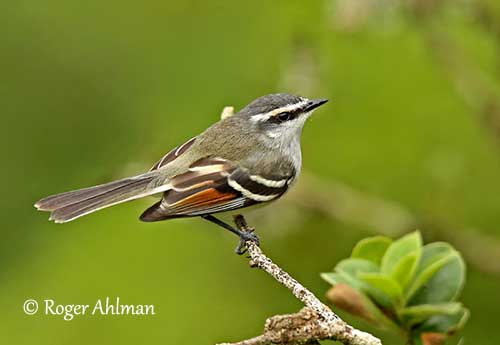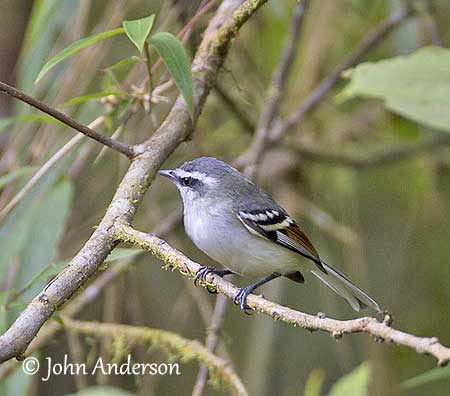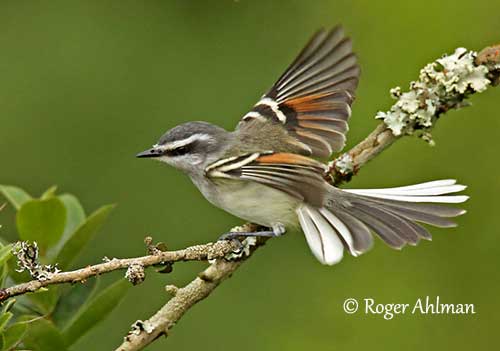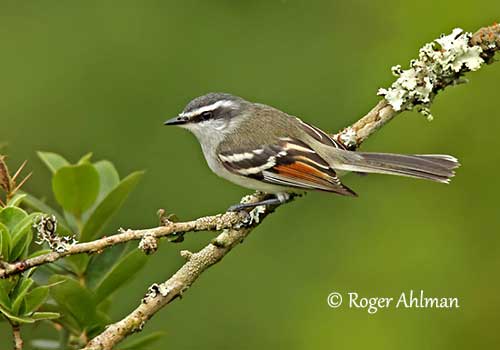
Fr: Tyranneau à ailes rousses
Ang: Rufous-winged Tyrannulet
All: Rotschwingen-Tachurityrann
Esp: Piojito Alirrufo
Ita: Tirannetto alirossicce
Nd: Roodvleugeltachuri
Sd: Rödvingad dvärgtyrann
Photographers:
Roger Ahlman
Pbase Galleries Peru and Ecuador
John Anderson
John Anderson Photo Galleries
Text by Nicole Bouglouan
Sources:
HANDBOOK OF THE BIRDS OF THE WORLD Vol 9 - by Josep del Hoyo - Andrew Elliot - David Christie - Lynx Edicions - ISBN: 8487334695
BIRDS OF SOUTH AMERICA – Passerines - by Robert S. Ridgely and Guy Tudor – HELM Field Guides – ISBN: 9781408113424
BIRDS OF PERU by Thomas S. Schulenberg, Douglas F. Stotz, Daniel F. Lane, John P. O’Neill, Theodore A. Parker III – Princeton University Press 2007– ISBN: 978-0-691-13023-1
L’ENCYCLOPEDIE MONDIALE DES OISEAUX - Dr Christopher M. Perrins - BORDAS - ISBN: 2040185607
Neotropical Birds – Cornell Lab of Ornithology
Wikipedia, la enciclopedia libre
Rufous-winged Tyrannulet
Mecocerculus calopterus
Passeriformes Order – Tyrannidae Family
INTRODUCTION:
The Rufous-winged Tyrannulet of genus Mecocerculus is part of the subfamily Elaeniinae in the large family Tyrannidae.
This species is very similar to warblers, and occurs in the temperate Andean cloud forest of Ecuador and N Peru. It often forages high in the forest canopy, sometimes within mixed-species flocks.
The Rufous-winged Tyrannulet is usually uncommon, but its population is currently stable.
DESCRIPTION OF THE BIRD:
Biometrics:
Length: 11 cm
Weight: 10-11 g
The Rufous-winged Tyrannulet has greenish-olive upperparts. The upperwing is blackish with two conspicuous white wingbars. The central flight feathers have black bases and rufous edges, forming a beautiful wing panel. The innermost and outermost remiges have yellowish edges. The tail is olive-brown with white outer two pairs of rectrices.
On the underparts, chin, throat and breast are pale grey. The belly is whitish and the undertail-coverts are pale yellow, but the undertail feathers are whitish.

On the head, the crown is slate-grey and the ear-coverts are blackish. We can see a conspicuous white supercilium extending from the forehead to above ear-coverts, and a broad, black eye line from lores, through the eye and ending on the ear-coverts. The lower face is whitish.
The thin bill is black. The eyes are dark brown. Legs and feet are dark grey.
Male and female are similar, but the juvenile is not described.
RANGE:
The Rufous-winged Tyrannulet is found in the Andes of W and SE Ecuador and N Peru, S to Lambayeque and La Libertad.
HABITAT:
The Rufous-winged Tyrannulet occurs mainly on lower Andean slopes, between 600 and 2200 metres of elevation, and occasionally down to 200 metres. It frequents the forest canopy of moist tropical forest and dry deciduous forests, both in mountainous areas and lowlands. It can be found in clearings with scattered trees, plantations and second growths.
CALLS AND SONGS: SOUNDS BY XENO-CANTO
The Rufous-winged Tyrannulet’s call is a hoarse, emphatic “pur-chee” with louder and higher-pitched second note. This call may be sometimes longer, with addition of lower notes “pur-chee, chi, chichu”.
It also utters a fast series of falling notes “kew-ki-ke-ke-ku-ku”.

BEHAVIOUR IN THE WILD:
The Rufous-winged Tyrannulet feeds mainly on various insect species. It is often seen singly or in pairs, but mates are loosely associated. They forage at middle and upper levels in the forest, searching for preys on leafy branches. They can join mixed-species flocks with other insect-eaters.
The Rufous-winged Tyrannulet feeds actively among the outer foliage of the canopy, usually in small-leafed trees. Insects are taken by perching and gleaning, and by short hovering in front of the vegetation and gleaning insects from the foliage.
Information about the breeding behaviour of this species is currently unavailable.
The tyrant-flycatchers are usually monogamous and territorial, defending their territories during the breeding season. They breed between January and June in N South America and Andes of Peru.
The courtship displays are unknown, but we can suggest that the rufous wing panel is enhanced by adapted postures, like the brown and white tail pattern and the broad, white supercilium. Displays are usually accompanied by song.
The Rufous-winged Tyrannulet is probably resident in its range, with some short altitudinal movements according to the season.
It performs brief hovering while gleaning insects from foliage, but the short, rounded wings do not allow long-distance flights.

REPRODUCTION OF THIS SPECIES:
The breeding season takes place from January to June.
There is no information about the nesting behaviour of the Rufous-winged Tyrannulet. However, the most usual nest-type is the open cup, with same general structure in all species. But the shape may vary from open cup to domed nest or pendent nest, depending on the species.
It is usually built by the female, well-hidden among the foliage in trees.
The clutch may include 2-8 whitish eggs with sometimes some brown speckles. The incubation varies from 12 to 16 days, performed by the female alone. The chicks are fed by both adults. They fledge 14-17 days after hatching.
PROTECTION / THREATS / STATUS:
The Rufous-winged Tyrannulet appears to be commoner on the W Andean slopes than on the E ones. This species occurs in several parks and reserves in Ecuador and N Peru.
It is rare to uncommon throughout the range, but the population is suspected to be stable.
The Rufous-winged Tyrannulet is currently evaluated as Least Concern.
